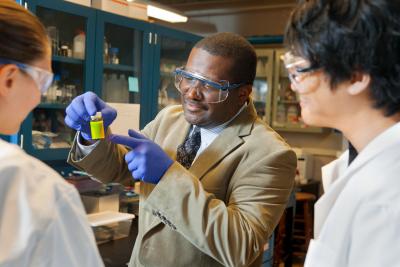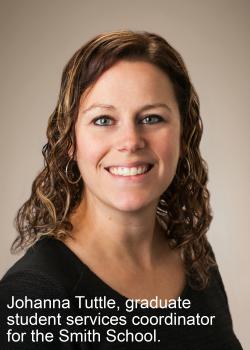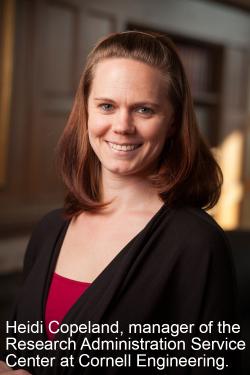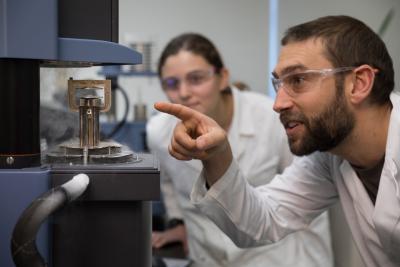Team Science: The People Working Behind the Scenes at Cornell Engineering
By Chris Dawson
The world-famous Riccardo Muti is now music director and chief conductor of the highly-regarded Chicago Symphony Orchestra. But do you know who the house manager is?
When the orchestra performs, who sets the music stands in their proper places? Who controls the lights and the sound and the curtains? Who makes sure Symphony Center is at the right temperature? Who prints the programs? Who tunes the piano? Who sweeps the floor in the lobby once everyone else has gone home?
An institution like the Chicago Symphony Orchestra needs more than a conductor and musicians, just as an institution like Cornell Engineering needs more than scientists and engineers. Neither can function without all of the many people who work behind the scenes to ensure every possible chance for success.
The professor
Lynden Archer, the James A. Friend Family Distinguished Professor of Engineering, is not a conductor, but like Muti, he is highly respected in his field. Archer recently ended a successful six-year term as director of Cornell’s Robert Frederick Smith School of Chemical and Biomolecular Engineering and has 20 patents either granted or pending, has won recognition for both his teaching and his research, and is also a Fellow of the American Physical Society. In his career, he has published more than 200 academic papers.
In conversation, it becomes evident that Archer has a deep understanding of, and appreciation for, the fact that he could not do what he does without the hard work and support of hundreds of talented and dedicated staff and students from the Smith School, Cornell Engineering and Cornell University.
“We have great facilities here at Cornell,” says Archer, “But facilities are not useful unless you have staff who are first-rate experts. This is essential. I don’t know how we do it, but we are able to hire skilled and dedicated staff people here across the board.”
Archer knows that to be so productive and successful as a researcher, he has relied on countless other people. Some of his co-authors help sharpen research ideas and questions, design experiments, examine results and collaborate on a final paper. But the vast majority are not co-authors and will probably never get a mention in an academic publication. They are the people who help create grant proposals and assist with accounting; they are the people who operate microscopes and spectroscopes; they are the people who clean and maintain all of the many facilities Archer and his colleagues use in their work; and they are the people in offices all across the campus who generally remain anonymous.
The work
To get a sense of just how many people there are powering the vast research engine that is Cornell Engineering, look at one recently published paper that resulted from research Lynden Archer carried out with several graduate students. The paper is titled “Highly Stable Sodium Batteries Enabled by Functional Ionic Polymer Membranes” and it appeared in the March 28, 2017, issue of Advanced Materials.
The paper is important because it takes scientists and engineers a few steps closer to replacing lithium-ion technology in batteries used to power most small electronic devices. Current lithium-ion battery technology is already operating at about 95 percent of its theoretical limits. It will be hard to squeeze much more efficiency out of these batteries. One obvious next step is to find a new material to use in the electrodes of the next generation of batteries.

Archer and several graduate students from his lab have shown that sodium-metal and sodium-ion batteries are worth pursuing as a replacement for lithium-ion batteries. Sodium has several advantages to lithium: it is low-cost, it is abundant and easy to procure, and it has the potential to produce more energy per unit volume than lithium.
However, sodium has a serious downside. It is very reactive. High reactivity can cause uneven deposition of sodium during battery recharge, which is a problem. Sodium’s high reactivity can also lead to continuous corrosion and a shortened battery life.
Archer and his students have shown that a sodium-metal anode protected by an ion-rich polymeric membrane can protect the metal against harmful reactions with the battery’s electrolyte and inhibit dendrite formation and growth. Solving these problems is an important step in finding a replacement for lithium-ion batteries.
Essential to this work was the ability of Archer and co-authors Shuya Wei, Ph.D. ’17, and Snehashis Choudhury, a doctoral student in the Archer Group, to see what was going on at the site of sodium deposition. They developed a clear casing for their battery and then used an in-situ optical microscope to directly visualize the deposition of sodium on a sodium-metal anode without the protective iron-rich membrane and with the protective membrane. They found a clear difference, with the protective membrane leading to a battery with high efficiency and stable long-term cycling through charging and discharging.
The team behind the work
Professor Archer is not the first author on the paper reporting this group’s results. Instead, two doctoral students from the Archer Lab are co-first authors. Other authors include two Ph.D. students from Archer’s lab; Pooja Nath and Zhengyuan Tu.
When students come to Cornell Engineering for graduate studies, there is a structure in place to help them succeed. Within the Smith School, Johanna Tuttle serves as the graduate student services coordinator. Susan Daniel, associate professor and director of graduate studies for the Smith School, says that Tuttle “does everything from admissions to graduation and anything in between. The grad students interact with Jo a lot.”
 Tuttle, who has been in her position at the Smith School for a year and a half, says, “I work with the students from application to graduation. Students rely on me for information regarding the program, and I help ensure that they are meeting or have met the requirements for their course of study. I love working with the students and watching them grow in their academic careers. They are brilliant young people who will shape our world tomorrow, so to be part of that is pretty awesome.”
Tuttle, who has been in her position at the Smith School for a year and a half, says, “I work with the students from application to graduation. Students rely on me for information regarding the program, and I help ensure that they are meeting or have met the requirements for their course of study. I love working with the students and watching them grow in their academic careers. They are brilliant young people who will shape our world tomorrow, so to be part of that is pretty awesome.”
Outside of the Smith School, students often rely on the staff of the Cornell University Graduate School to secure funding and provide professional development and networking opportunities. If the graduate students are from countries outside of the United States, the International Students and Scholars Office and its staff of nine are there to answer questions about travel documents and permissions, tax laws and labor regulations, as well as personal, academic and cultural matters.
Celia Szczepura-McLean, former director of administration for the Smith School, says "The staff in CBE all do their jobs as defined, but they also willingly take on projects and fulfill needs as they arise. They work well together, support each other and share a common goal of personally engaging with our students, faculty and each other in supporting top notch teaching and cutting-edge research programs."
One of the people Szczepura-McLean is talking about is Sally Carland, a now-retired accounts representative in the Smith School. In talking about the National Science Foundation grant that enabled his work for this paper, Archer praised Carland.
“She was so helpful to me on this grant, she ended up teaching me,” said Archer.
Carland reciprocates Archer’s appreciation.
“I have the utmost respect for Lynden,” says Carland. “We could be honest and open about our own points of view to come up with the best solution. I felt honored to be part of his team. My goal was to be supportive and assist Lynden and his research group in reaching their objectives. This was truly a rewarding role for me.”
The role Carland played for Archer has largely been subsumed in the mission of the newly created Research Administration Service Center at Cornell Engineering, which provides faculty with pre-award research administration services. Those services include identifying and disseminating funding opportunities to all faculty, and providing support for research and center proposals. The center comprises five pre-award administrators and an administrative assistant.
In the same way that most of the research at Cornell Engineering cannot happen without skilled, dedicated staff people in support roles throughout the college, it also cannot happen without funding. The vast majority of financial support for most of the research taking place across the college comes from competitive grants. RASC exists to help professors navigate the often-demanding path from inspiration to funded experiment.
 Heidi Copeland, manager of RASC, understands just how important it is to keep the money coming in.
Heidi Copeland, manager of RASC, understands just how important it is to keep the money coming in.
“Grant funding contributes a significant amount of financial resources to Cornell Engineering, and to Cornell University as a whole,” says Copeland. “This funding enables faculty and research teams to conduct a wide array of research studies for which funding may not otherwise be available. With this funding they can explore and solve real-world problems and improve lives.”
Copeland just recently joined the RASC office and has been impressed by her colleagues.
“The RASC team never ceases to amaze me,” says Copeland. “They are one of the most talented and engaged teams that I have ever had the pleasure of working with. They all have highly demanding workloads, with each of them juggling several proposals and often-conflicting deadlines. They feel a strong sense of responsibility to the success of a proposal submission, and take their mission very seriously.”
Once Archer proposed his idea to the National Science Foundation and received approval and funding, he and his students then had to do the research. Some of the technical work of creating the materials needed for Archer’s battery was performed in Archer’s lab in Olin Hall. Other portions of the work were carried out in various facilities run by the Cornell Center for Materials Research (CCMR). It was essential for Archer and his team to see what was happening at the site of sodium deposition in their battery, and the materials scientists at CCMR have many tools and techniques for doing that. “Material characterization” is another term for the general process by which a material's structure and properties are probed and measured. The process involves some very sophisticated equipment.
Archer’s former Ph.D. student Shuya Wei, who is now in a postdoctoral position at MIT, has nothing but praise for the CCMR staff who helped with the material characterization.
“I was an active user of the CCMR facilities and I got a lot of help from the people who are in charge of the instruments,” says Wei.
In addition to technical staff, CCMR has an administrative staff of nine people to manage scheduling, outreach, finances, systems analysis and all other aspects of their extensive shared facilities. Melissa Hines has been the director of CCMR for 12 years.
“I am particularly proud of the fact that our staff are willing and able to help people at all levels of expertise,” says Hines, “from small business owners trying to solve technical challenges to undergraduate students working on their first research projects to advanced users with years of experience. One woman found our facilities on the internet and sent us a pair of star rubies for X-ray analysis because she thought they were cursed!” Hines makes it clear that X-ray analysis of these rubies produced beautiful diffraction patterns but no evidence of a curse.
Wei says, “Mick Thomas trained me to use the secondary electron microscope and he was so helpful. He also helped us run our image samples if we couldn’t get optimal images.” Thomas has worked at CCMR for 30 years and genuinely love his job.
“The part I like best is working with the students and having a role in helping them reach their goals,” says Thomas, a facility manager. “Many of the students coming into the lab have had little or no opportunity to operate an electron microscope before and it is rewarding to watch them progress and become highly skilled microscopists.”
 Archer and his students also used the Cornell University Nuclear Magnetic Resonance facility (CUNMR) and the Center for Nanomaterials Engineering and Technology (CNET) in Kimball Hall. Both of these facilities have highly trained and helpful staff.
Archer and his students also used the Cornell University Nuclear Magnetic Resonance facility (CUNMR) and the Center for Nanomaterials Engineering and Technology (CNET) in Kimball Hall. Both of these facilities have highly trained and helpful staff.
Wei says, “Ivan Keresztes and Anthony Condo in the CUNMR facilities trained me to use the NMR and mass spectra, and gave insightful analysis of my data. Brenda Fisher in CNET maintains the facilities there and trained me in their use.”
The big picture
In any given year, the approximately 250 professors of Cornell Engineering publish hundreds of academic papers based on research carried out all around the world. A research endeavor of this size requires hundreds of people in supporting roles to make it all work. There are 165 employees across the college who support students and professors, maintain and operate facilities, and ensure Cornell Engineering produces cutting-edge research while retaining its place among the most highly-ranked schools of engineering in the world.
As a world-class research university, Cornell has three missions: Learning, discovery and engagement. Erin Mulrooney, associate dean for administration, understands first-hand the importance of having skilled and dedicated people at all levels of an organization like Cornell Engineering. Having spent 26 years in higher education, Mulrooney has a deep appreciation for the behind-the-scenes heavy lifting that occurs in the staff corps to support these vital missions.
“We are all quite lucky indeed to serve faculty who are transforming and improving the world around us," says Mulrooney. "Researchers here are changing the way we think about and treat cancer. They are creating new, more efficient energy storage materials to greatly improve battery capacity and life. They are using smart devices to design integrated and efficient transportation systems for cities. They are doing all of these things, and many more, with the support of skilled and dedicated staff."
Unlike an industrial research and development lab, Cornell researchers are charged with educating the next generation of engineers and innovators.
"While engaging in research, professors are also teaching our exceptional students, many of whom will go on to do even more great things," continues Mulrooney. "Cornell Engineering staff have an incredible opportunity to be a part of these important advances. To support professors and students, staff perform myriad functions, mostly behind the scenes, including organizing conferences, advising students, overseeing lab renovations, ensuring compliance with research awards, stewarding our donors, developing databases, updating websites and the list could go on. We can all take pride in our individual and collective contributions to Cornell Engineering—it's exciting to do meaningful work that truly impacts the world."
When the snow falls and professors need to get to a shared facility somewhere across campus, there are people who have cleared the sidewalk and spread rock salt. When the wastebaskets are full in the office or the lab, someone empties them. When an inaccessible lightbulb burns out, a person replaces it. When a grad student goes to write an equation on a whiteboard, somebody has made sure there are markers handy. These things do not happen on their own. There are people who do these tasks every day and because they do what they do, researchers like Lynden Archer and his students can do what they do.
When you look at the list of authors on research publications from Cornell Engineering faculty, you will not see the names of the people who scheduled the lab time, took care of the grant accounting, emptied the recycling bins, installed the wireless router and handled the million other small and thankless tasks that keep things moving efficiently, but they are certainly an important part of the team that allows Cornell to be the engineering research powerhouse that it is.

